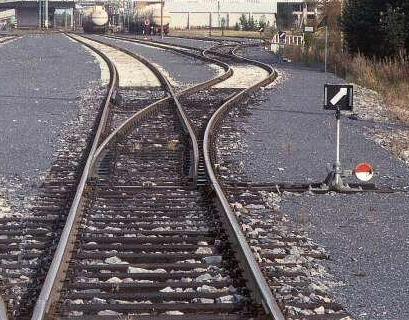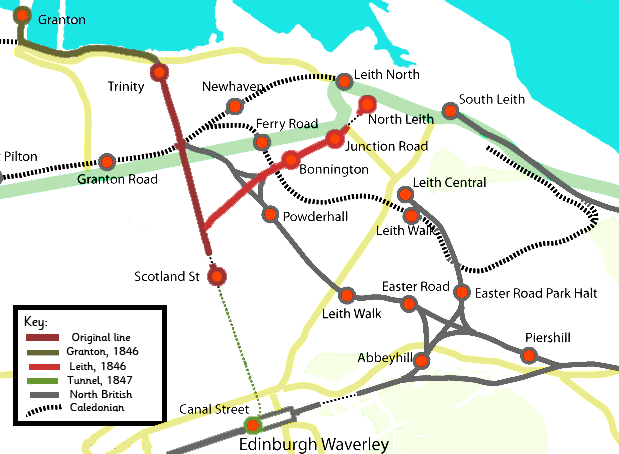|
Headshunt
A headshunt (or escape track in the United States) is a short length of track provided to release locomotives at terminal platforms, or to allow shunting to take place clear of main lines. Terminal headshunt A 'terminal headshunt' is a short length of track that allows a locomotive to uncouple from its train, move forward, and then run back past it on a parallel track. Such headshunts are typically installed at a terminal station to allow the locomotive of an arriving train to move to the opposite end of (in railway parlance, 'run around') its train so that it can then haul the same train out of the station in the other direction (assuming, of course, that it is a locomotive equipped to run in either direction; for locomotives that only operate in one direction, a wye or turntable needs to be provided to physically turn the engine around, as well as a run-around track). Reversing headshunt Found primarily on metro systems, rapid transit light rail networks, and tramways, a ... [...More Info...] [...Related Items...] OR: [Wikipedia] [Google] [Baidu] |
Wye (rail)
In railroad structures, and rail terminology, a wye (like the'' 'Y' ''glyph) or triangular junction (often shortened to just "triangle") is a triangular joining arrangement of three rail lines with a railroad switch (set of points) at each corner connecting to each incoming line. A turning wye is a specific case. Where two rail lines join, or in a joint between a railroad's mainline and a spur, wyes can be used at a mainline rail junction to allow incoming trains the ability to travel in either direction, or in order to allow trains to pass from one line to the other line. Wyes can also be used for turning railway equipment, and generally cover less area than a balloon loop doing the same job, but at the cost of two additional sets of points to construct, then maintain. These turnings are accomplished by performing the railway equivalent of a three-point turn through successive junctions of the wye, the direction of travel and the relative orientation of a locomotive or r ... [...More Info...] [...Related Items...] OR: [Wikipedia] [Google] [Baidu] |
Rail Yard
A rail yard, railway yard, railroad yard (US) or simply yard, is a series of tracks in a rail network for storing, sorting, or loading and unloading rail vehicles and locomotives. Yards have many tracks in parallel for keeping rolling stock or unused locomotives stored off the main line, so that they do not obstruct the flow of traffic. Cars or wagons are moved around by specially designed yard switchers (US) or shunters, a type of locomotive. Cars or wagons in a yard may be sorted by numerous categories, including railway company, loaded or unloaded, destination, car type, or whether they need repairs. Yards are normally built where there is a need to store rail vehicles while they are not being loaded or unloaded, or are waiting to be assembled into trains. Large yards may have a tower to control operations. Many yards are located at strategic points on a main line. Main-line yards are often composed of an up yard and a down yard, linked to the associated direction of tr ... [...More Info...] [...Related Items...] OR: [Wikipedia] [Google] [Baidu] |
Manchester Central Railway Station
Manchester Central railway station is a former railway station in Manchester city centre, England. One of Manchester's main railway terminals between 1880 and 1969, it has been converted into an exhibition and conference centre, originally known as G-MEX, but now named Manchester Central. The structure is a Grade II* listed building. On 27 March 2020, the UK government announced that the building would be converted into an emergency hospital, intended to deal with the COVID-19 pandemic and with 1,000 beds. History The station was built between 1875 and 1880 by the Cheshire Lines Committee (CLC), and was officially opened on 1 July 1880. The architect was Sir John Fowler and the engineers were Richard Johnson, Andrew Johnston and Charles Sacré for the three companies which formed the CLC. While it was being built, a temporary facility, Manchester Free Trade Hall Station (after the Free Trade Hall a landmark building nearby) was in use from 9 September 1877. It had two woode ... [...More Info...] [...Related Items...] OR: [Wikipedia] [Google] [Baidu] |
Railroad Switch
A railroad switch (), turnout, or ''set ofpoints () is a mechanical installation enabling railway trains to be guided from one track to another, such as at a railway junction or where a spur or siding branches off. The most common type of switch consists of a pair of linked tapering rails, known as ''points'' (''switch rails'' or ''point blades''), lying between the diverging outer rails (the ''stock rails''). These points can be moved laterally into one of two positions to direct a train coming from the point blades toward the straight path or the diverging path. A train moving from the narrow end toward the point blades (i.e. it will be directed to one of the two paths, depending on the position of the points) is said to be executing a ''facing-point movement''. For many types of switch, a train coming from either of the converging directions will pass through the switch regardless of the position of the points, as the vehicle's wheels will force the points to mov ... [...More Info...] [...Related Items...] OR: [Wikipedia] [Google] [Baidu] |
Edinburgh Waverley Railway Station
Edinburgh Waverley railway station (also known simply as Waverley; gd, Waverley Dhùn Èideann) is the principal railway station serving Edinburgh, Scotland. It is the second busiest station in Scotland, after Glasgow Central. It is the northern terminus of the East Coast Main Line, from , although some trains operated by London North Eastern Railway continue to other Scottish destinations beyond Edinburgh. Location Waverley station is situated in a steep, narrow valley between the medieval Old Town and the 18th century New Town. Princes Street, the premier shopping street, runs close to its north side. The valley is bridged by the North Bridge, rebuilt in 1897 as a three-span iron and steel bridge, on huge sandstone piers. This passes high above the station's central section, with the greater half of the station being west of North Bridge. The central booking hall is just west of the northern massive stone pier of the bridge and cleverly hides it within its bulk. Wa ... [...More Info...] [...Related Items...] OR: [Wikipedia] [Google] [Baidu] |
Freight Rail
Rail freight transport is the use of railroads and trains to transport cargo as opposed to human passengers. A freight train, cargo train, or goods train is a group of freight cars (US) or goods wagons ( International Union of Railways) hauled by one or more locomotives on a railway, transporting cargo all or some of the way between the shipper and the intended destination as part of the logistics chain. Trains may haul bulk material, intermodal containers, general freight or specialized freight in purpose-designed cars. Rail freight practices and economics vary by country and region. When considered in terms of ton-miles or tonne-kilometers hauled per unit of energy consumed, rail transport can be more efficient than other means of transportation. Maximum economies are typically realized with bulk commodities (e.g., coal), especially when hauled over long distances. However, shipment by rail is not as flexible as by the highway, which has resulted in much freight be ... [...More Info...] [...Related Items...] OR: [Wikipedia] [Google] [Baidu] |
Victoria (Australia)
Victoria is a state in southeastern Australia. It is the second-smallest state with a land area of , the second most populated state (after New South Wales) with a population of over 6.5 million, and the most densely populated state in Australia (28 per km2). Victoria is bordered by New South Wales to the north and South Australia to the west, and is bounded by the Bass Strait to the south (with the exception of a small land border with Tasmania located along Boundary Islet), the Great Australian Bight portion of the Southern Ocean to the southwest, and the Tasman Sea (a marginal sea of the South Pacific Ocean) to the southeast. The state encompasses a range of climates and geographical features from its temperate coastal and central regions to the Victorian Alps in the northeast and the semi-arid north-west. The majority of the Victorian population is concentrated in the central-south area surrounding Port Phillip Bay, and in particular within the metr ... [...More Info...] [...Related Items...] OR: [Wikipedia] [Google] [Baidu] |
.jpg)




